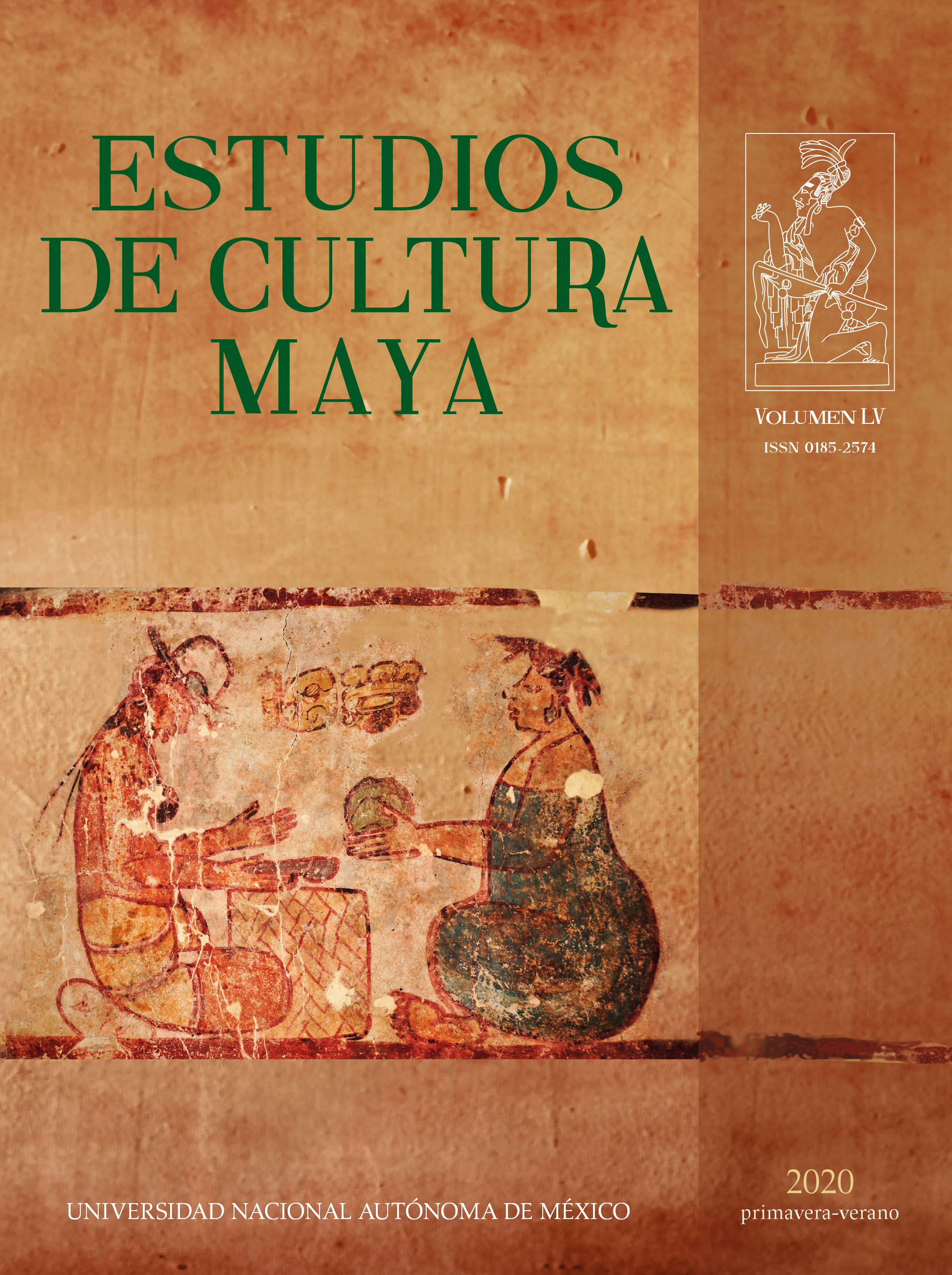Hidden in Plain Sight: The Codical Sign T648 and its Forerunner T694 in Three Classic Period Contexts
Contenido principal del artículo
Resumen
The grapheme T648 in the Maya script occurs exclusively in the Postclassic period. Whether it is a CV syllable or a CVC logogram has been in question. In this paper we resolve that issue. Also, we suggest that the Classic version of the sign is T694, which led us to query relevant environments of both versions of the grapheme. We have found a solid substitution in the Postclassic codices with which we can answer several unknown collocations in the Classic Period. We offer CVC and V values for T648/694 and demonstrate their productivity in different contexts.
Detalles del artículo
El autor o autores se compromete(n) a firmar una declaración autorizando la publicación en los distintos soportes y espacios de difusión de Estudios de CulturaMaya y cediendo los derechos patrimoniales sobre la obra en forma total y exclusiva a la Universidad Nacional Autónoma de México, conforme a lo establecido en el artículo 84 de la Ley Federal del Derecho de Autor y demás relativos y aplicables a su reglamento, en el entendido de que será respetado su derecho autoral sobre la obra, se les otorgará el crédito correspondiente y recibirá(n) un ejemplar del número de Estudios donde aparezca el artículo
Citas
Aldana, Gerardo
“Oracular Science: Uncertainty in the History of Maya stronomy”, Ph.D dissertation. Cambridge: Harvard University.
Tying Headbands or Venus Appearing: New Translations of /k’al/, the Dresden Codex Venus Pages, and Royal ‘Binding’ Rituals. Oxford: Archaeopress (B.A.R. International Series, 2239).
“An Oracular Hypothesis: The Dresden Codex Venus Table and Cultural Translations of Science”, Archaeoastronomy and the Maya, pp. 77-96, Gerardo Aldana and Edwin Barnhart (eds.). Oxford: Oxbow Books.
Barrera Vásquez, Alfredo (ed.)
Diccionario Maya Cordemex. Mérida: Ediciones Cordemex.
Bassie-Sweet, Karen
n.d. Maya Gods of War. Book manuscript in preparation.
Becquelin, Pierre and Claude Baudez
Toniná, une cité Maya de Chiapas. Mexico: Mission Archéologique et Ethnologique Française au Mexique.
Beliaev, Dmitri
“Wayaab’ Title in Maya Hieroglyphic Inscriptions: On the Problem of Religious Specialization in Classic Maya Society”, Continuity and Change: Maya Religious Practices in Temporal Perspective, 5th European Maya Conference, Acta Mesoamericana, 14: 121-130,
“Río Azul Dynasty and Polity: New Epigraphic Evidence”, Third Annual "Textdatenbank und Wörterbuch des Klassischen Maya" Workshop, Bonn University, December 7-9, 2017. Bonn.
Beliaev, Dmitri and Alexander Safronov
“Династическая история Йокиба вовторой половине VIII в”. Вопросы эпиграфнкн. Выпуск VIII, частъ 1, pp. 533-599, Александр Григорьевич Авдеев (ed.). Moscow: Dmitry Pozharsky University and School.
Bernal Romero, Guillermo
“Analísis epigráfico del Tablero de K’anTok, Palenque, Chiapas”, La organización social entre los mayas prehispánicos, coloniales y modernos. Memoria de la Tercera Mesa Redonda de Palenque, pp. 401-423. México: Consejo Nacional para la Cultura y las Artes.
El Tablero de K'anTok: una inscripción glífica maya del Grupo XVI de Palenque, Chiapas. México: Universidad Nacional Autónoma de México, Instituto de Investigaciones Filológicas, Centro de Estudios Mayas.
Bíró, Péter
“Piedras Negras Panel 3: Some Thoughts on Spoken Words”, Indiana, 28: 291-313.
“The Non-Existing May Cycle: Methods, Colonial Texts and Epigraphs”, Journal de la Société des Américanistes, 92 (2): 33-57.
“A New Teotiwa Lord of the South: K’ahk’ Uti’ Chan Yopat (578-628 C.E.) and the Renaissance of Copan”, Glyph Dwellers, Report 57, <http://glyphdwellers.com/pdf/R57.pdf> [accessed in 20, March 2019].
Bolles, David
Combined Dictionary-Concordance of the Yucatecan Mayan Language (Foundation for the Advancement of Mesoamerican Studies), <http://www.famsi.org/reports/96072/index.html> [accessed in 20, March 2019]
Post Conquest Mayan Literature. Based on Pre-Columbian Sources. Culver City: Labyrinthos.
Bricker, Harvey M. and Victoria Bricker
Astronomy in the Maya Codices. Philadelphia: American Philosophical Society (Memoirs of the American Philosophical Society Held at Philadelphia for Promoting Useful Knowledge, 265).
Bricker, Victoria, Eleuterio Poot Yah and Ofelia Dzul.
A Dictionary of the Maya Language as Spoken in Hocabá, Yucatán. Salt Lake City: The University of Brigham Young.
Cervantes, Angelica, Jose Linares and Esther Quintero
“An Updated Checklist of the Mexican Species of Dalbergia (Leguminosae) to Aid in its Conservation Efforts”, Revista Mexicana de Biodiversidad, 90: e902528. DOI: https://doi.org/10.22201/ib.20078706e.2019.90.2528.
Closs, Michael
“Cognitive Aspects of Ancient Maya Eclipse Theory”, World Archaeoastronomy, pp. 389-415, Anthony F. Aveni (ed.). Cambridge, England: Cambridge University Press.
Förstemann, Ernst
Die Maya Handschrift der Köneglichen öffentlichen Bibliothek zu Dresden. Zweite Auflage. Mit 74 Tafeln in Chromo-Lichdruck. Dresden: R. Bertling (Foundation for Advancement of Mesoamerican Studies), <http://www.famsi.org/mayawriting/codices/dresden.html> [accessed in 20, March 2019].
GBIF Backbone Taxonomy
“Dalbergiaglabra Standl”, Catalogue of Life. DOI:10.15468/39omei.
González Cruz, Arnoldo and Guillermo Bernal Romero
“The Discovery of the Temple XXI Monument at Palenque: The Kingdom of Baakal during the Reign of K’inich Ahkal Mo’ Nahb”, Maya Archaeology, 2: 82-103, Charles Golden, Stephen Houston and Joel Skidmore (eds.). San Francisco: Precolumbian Mesoweb Press.
Grube, Nikolai
Der Dresdner Maya-Kalender: Der vollständige Codex. Freiburg im Breisgau: Verlag Herder GmbH.
Grube, Nikolai and Maria Gaida
Die Maya: Schrift und Kunst. Berlin: SMB-Dumont.
Hofling, Charles Andrew and Félix Fernando Tesucún
Itzaj Maya-Spanish-English Dictionary. Salt Lake City: University of Utah Press.
Hull, Kerry
A Dictionary of Ch’orti’: Mayan-Spanish-English. Salt Lake City: University of Utah Press.
Kaufman, Terrence
Tzeltal Phonology and Morphology. Berkeley: University of California Press.
Kaufman, Terrence and John S. Justeson
“A Preliminary Mayan Etymological Dictionary” (Foundation for the Advancement of Mesoamerican Studies), <http://www.famsi.org/reports/01051/index.html> [accessed in 20, March 2019].
Kaufman, Terrence and William Norman
“An Outline of Proto-Cholan Phonology, Morphology, and Vocabulary”, Phoneticism in Mayan Hieroglyphic Writing, pp. 77-166, John Justeson and Lyle Campbell (eds.). Albany: Institute for Mesoamerican Studies (Publication, 9).
Law, Danny and David Stuart
“Classic Mayan: An Overview of Language in Ancient Hieroglyphic Script”, The Mayan Languages, pp. 128-172, Judith Aissen, Nora C. England and Roberto Zavala (eds.). New York: Rutledge Language Family Series.
Looper, Matthew
“A ‘Macaw Face Headband’ Dance on Site R Lintel 5”, Glyph Dwellers. Report 18, <http://glyphdwellers.com/pdf/R18.pdf> [accessed in 20, March 2019].
Lounsbury, Floyd G.
“Astronomical Knowledge and its Uses at Bonampak, Mexico”, Archaeoastronomy in the New World, pp. 143-169, Anthony F. Aveni (ed.). Cambridge: Cambridge University Press.
MacLeod, Barbara
“A Word in a Grain of Sand. Transitive Perfect Verbs in the Classic Maya Script”, The Linguistics of Maya Writing, pp. 291-325, Søren Wichmann (ed.). Salt Lake City: The University of Utah Press.
Macri, Martha and Gabrielle Vail
The New Catalog of Maya Hieroglyphs, Volume Two: Codical Texts. Norman: University of Oklahoma Press (The Civilization of the American Indian Series).
Madrid Codex
Codex Tro-Cortesianus. Codices Selecti Series, Volume 8. Graz: Akademische Druck- und Verlagsanstalt (Foundation for the Advancement of Mesoamerican Studies), <http://www.famsi.org/research/graz/madrid/index.html> [accessed in 20, March 2019].
Milbrath, Susan
Star Gods of the Maya: Astronomy in Art, Folklore, and Calendars. Austin:
University of Texas Press.
Paris Codex
Codex Peresianus. Codices Selecti Series, Volume 9. Graz: Akademische Druck- und Verlagsanstalt (Foundation for the Advancement of Mesoamerican Studies), <http://www.famsi.org/research/graz/paris/index.html> [accessed in 20, March 2019].
Plank, Shannon E.
Maya Dwellings in Hieroglyphs and Archaeology: Maya Dwellings in Hieroglyphs and Archaeology. Oxford: Archaeopress (BAR International Series, 1324).
Polyukhovych, Yuriy
The “Banded Bird” Title as NAAT, “Sage, Prophet”. Unpublished manuscript.
Prager, Christian
“Übernatürliche Akteure in der Klassischen Maya-Region”, PhD thesis in Anthropology. Bonn: University of Bonn, <https://hss.ulb.uni-bonn.de/2014/3539/3539-2.pdf> [accessed in 20 March, 2019].
Riese, Berthold and Frauke J. Riese
“Structure 11 at the Classic Maya City of Copán, Honduras”, Baessler-Archiv, XXXIX: 209-257.
Roys, Ralph L.
Ethno-Botany of the Maya. New Orleans: Tulane University, Department of Middle American Research (Middle American Research Series, 2).
Sanz González, Mariano
“La categoría de tiempo en las inscripciones mayas del período Clásico”, tesis de doctorado en Historia. Madrid: Universidad Complutense.
Schele, Linda and Nikolai Grube
Notebook for the XXI Maya Hieroglyphic Workshop: The Dresden Codex. Austin: University of Texas at Austin, Institute of Latin American Studies.
Schele, Linda and Peter Mathews
Bodega of Palenque, Chiapas, Mexico. Washington: Dumbarton Oaks Research Library and Collection.
Schele, Linda, David Stuart, and Nikolai Grube
“A Commentary on the Restoration and Reading of the Glyphic Panels from Temple 11”, Copán Note, 64. Austin: Copan Mosaics Project, Instituto Hondureño de Antropologia e Historia.
Stone, Andrea and Marc Zender
Reading Maya Art. A Hieroglyphic Guide to Ancient Maya Painting and Sculpture. London: Thames and Hudson.
Stross, Brian
n.d. Ch’orti’ Dictionary after Wisdom. Transcribed by B. Stross. Unpublished manuscript.
Stuart, David
The Inscriptions from Temple XIX at Palenque. San Francisco: The Pre-Columbian Art Research Institute.
Stuart, David, Stephen D. Houston, and John Robertson
Recovering the Past: Classic Maya Language and Classic Maya Gods. Notebook for the XXIIIrd Maya Hieroglyphic Forum at Texas, Part II. Austin: University of Texas Press, Maya Workshop Foundation.
Tedlock, Barbara
Time and the Highland Maya. Albuquerque: University of New Mexico Press.
Tedlock, Dennis
2000 years of Mayan Literature. Berkeley and Los Angeles: University of California Press.
Thompson, John Eric S.
“Explorations in Campeche and Quintana Roo and Excavations at San José, British Honduras”, Carnegie Institution of Washington Year Book, 35, pp. 125-128. Washington: Carnegie Institution.
Maya Hieroglyphic Writing: Introduction. Washington: Carnegie Institution of Washington (Publication 598).
Tokovinine, Alexandre and Marc Zender
“Lords of Windy Water: The Royal Court of Motul de San José in Classic Maya Inscriptions”, Motul de San José: Politics, History, and Economy, in a Classic Maya Polity, pp. 30-66, Antonia E. Foias and Kitty E. Emery (eds.). Gainesville: University Press of Florida.
Tsukamoto, Kenichiro, Hirokazu Kotegawa, and Luz Evelia Campaña
“Secuencia constructiva de las plazas en el Grupo Principal de El Palmar, Campeche, México”, Estudios de Cultura Maya, XXXIX: 11-30. DOI: https://doi.org/10.19130/iifl.ecm.2012.39.57.
Tsukamoto, Kenichiro and Octavio Q. Esparza Olguín
“Ajpach’ Waal: The Hieroglyphic Strairway of the Guzmán Group of El Palmar, Campeche, Mexico”, Maya Archaeology, 3: 30-55, Charles Golden, Stephen Houston y Joel Skidmore (eds.). San Francisco: Precolumbia Mesoweb Press.
Velásquez García, Erik
“Códice de Dresde, parte 2”, Arqueología Mexicana, Edición especial 72.
Wichmann, Søren
“The Names of Some Major Classic Maya Gods”, Continuity and Change–Mayan Religious Practices in Temporal Perspective. 5th European Maya Conference, pp. 77-86, Daniel Graña Behrens, Nikolai Grube, Christian M. Prager, Frauke Sachse, Stefanie Teufel, and Elisabeth Wagner (eds.), Acta Americana, Volume 14. Markt Schwaben: Verlag Anton Saurwein.
Zender, Marc
K'ahlaj Sak Huun Tu Baah: The Crown was Held Above Him. Presentation to the Institute of Maya Studies, May 18, 2016, Miami, <https://www.academia.edu/29356341/_The_Crown_Was_Held_Above_Him_Revisiting_a_Classic_Maya_Coronation_Ceremony> [accessed in 20, March 2019].






